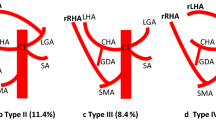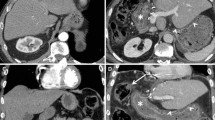Abstract
Objectives
To illustrate the multidetector computed tomography (MDCT) findings in patients with end-stage biliary atresia (BA).
Methods
The study group consists of 45 consecutive patients with BA who underwent MDCT before liver transplantation from February 2005 to February 2008. Mean age was 36 months, 24 patients were female, and 22 had undergone a previous Kasai procedure.
Results
MDCT detected a total of 15 hepatocellular nodules in 7 patients. Intrahepatic biliary cysts were detected in 14 patients and were significantly associated with a Kasai procedure. Intrahepatic porto-systemic shunts were found in 14 patients (31%), intrahepatic communicating vessels between hepatic veins were found in 24 patients (53%). Anatomical variants of hepatic artery were detected in 21 patients. Seven patients (15%) had portal vein thrombosis; in 12 cases (26%) portal vein diameter was 3 mm or less.
Conclusion
MDCT can provide accurate morphological and vascular assessment of patients with end-stage biliary atresia and should be used for precise surgical planning. To the best of our knowledge this is one of the first studies to show the presence of numerous veno-venous communications in BA.







Similar content being viewed by others
References
Humphrey TM, Stringer MD (2007) Biliary atresia: US diagnosis. Radiology 244:845–851
Liu YW, Concejero AM, Chen CL et al (2007) Hepatic pseudotumor in long-standing biliary atresia patients undergoing liver transplantation. Liver Transpl 13:1545–1551
McKiernan PJ, Baker AJ, Kelly DA (2000) The frequency and outcome of biliary atresia in the UK and Ireland. Lancet 355:25–29
Chen TY, Chen CL, Huang TL et al (2003) Noninvasive multislice CT angiography in pediatric liver transplantation: a novel application. Transplant Proc 35:62–63
Cheng YF, Chen CL, Jawan B et al (2003) Multislice computed tomography angiography in pediatric liver transplantation. Transplantation 76:353–357
Tanano H, Hasegawa T, Kawahara H, Sasaki T, Okada A (1999) Biliary atresia associated with congenital structural anomalies. J Pediatr Surg 34:1687–1690
Hasegawa T, Kimura T, Sasaki T, Okada A (2002) Living-related liver transplantation for biliary atresia associated with polysplenia syndrome. Pediatr Transplant 6:78–81
Frush DP (2008) Pediatric abdominal CT angiography. Pediatr Radiol 38(suppl 2):S259–S266
Dillman JR, Strouse PJ, Ellis JH et al (2007) Incidence and severity of acute allergic like reactions to IV nonionic iodinated contrast material in children. AJR 188:1643–1647
Kim WS, Cheon JE, Youn BJ et al (2007) Hepatic arterial diameter measured with US: adjunct for US diagnosis of biliary atresia. Radiology 245:549–555
dos Santos JL, da Silveira TR, da Silva VD, Cerski CT, Wagner MB (2005) Medial thickening of hepatic artery branches in biliary atresia. A morphometric study. J Pediatr Surg 40:637–642
Miga D, Sokol RJ, MacKenzie T, Narkewicz MR, Smith D, Karrer FM (2001) Survival after first esophageal variceal hemorrhage in patients with biliary atresia. J Pediatr 139:291–296
Lykavieris P, Chardot C, Sokhn M, Gauthier F, Valayer J, Bernard O (2005) Outcome in adulthood of biliary atresia: a study of 63 patients who survived for over 20 years with their native liver. Hepatology 41:366–371
Witters P, Maleux G, George C et al (2008) Congenital veno-venous malformations of the liver: widely variable clinical presentations. J Gastroenterol Hepatol 23:e390–394
Valls E, Ceres L, Urbaneja A, Munoz R, Alonso I (2000) Color Doppler sonography in the diagnosis of neonatal intrahepatic portosystemic shunts. J Clin Ultrasound 28:42–46
Yamagami T, Nakamura T, Tokiwa K, Ohno K, Itoh H, Maeda T (2000) Intrahepatic portosystemic venous shunt associated with biliary atresia: case report. Pediatr Radiol 30:489–491
Okuda K (2002) Non-cirrhotic portal hypertension versus idiopathic portal hypertension. J Gastroenterol Hepatol 17(Suppl 3):S204–213
Liang JL, Cheng YF, Concejero AM et al (2008) Macro-regenerative nodules in biliary atresia: CT/MRI findings and their pathological relations. World J Gastroenterol 14:4529–4534
Hol L, van den Bos IC, Hussain SM, Zondervan PE, de Man RA (2008) Hepatocellular carcinoma complicating biliary atresia after Kasai portoenterostomy. Eur J Gastroenterol Hepatol 20:227–231
Sharp L, Makin E, Davenport M (2008) Hepatic haemangioendothelioma: a vertical association with biliary atresia? Eur J Pediatr Surg 18:277–279
Tatekawa Y, Asonuma K, Uemoto S, Inomata Y, Tanaka K (2001) Liver transplantation for biliary atresia associated with malignant hepatic tumors. J Pediatr Surg 36:436–439
Takahashi A, Tsuchida Y, Suzuki N et al (1999) Incidence of intrahepatic biliary cysts in biliary atresia after hepatic portoenterostomy and associated histopathologic findings in the liver and porta hepatis at diagnosis. J Pediatr Surg 34:1364–1368
Takahashi A, Tsuchida Y, Suzuki N et al (2003) Intrahepatic biliary cysts in biliary atresia in the era of liver transplantation. J Pediatr Gastroenterol Nutr 36:608–612
Watanabe M, Hori T, Kaneko M et al (2007) Intrahepatic biliary cysts in children with biliary atresia who have had a Kasai operation. J Pediatr Surg 42:1185–1189
Tainaka T, Kaneko K, Seo T, Ono Y, Sumida W, Ando H (2007) Intrahepatic cystic lesions after hepatic portoenterostomy for biliary atresia with bile lake and dilated bile ducts. J Pediatr Gastroenterol Nutr 44:104–107
Tsuchida Y, Honna T, Kawarasaki H (1994) Cystic dilatation of the intrahepatic biliary system in biliary atresia after hepatic portoenterostomy. J Pediatr Surg 29:630–634
Author information
Authors and Affiliations
Corresponding author
Rights and permissions
About this article
Cite this article
Caruso, S., Miraglia, R., Milazzo, M. et al. Multidetector computed tomography hepatic findings in children with end-stage biliary atresia. Eur Radiol 20, 1468–1475 (2010). https://doi.org/10.1007/s00330-009-1681-2
Received:
Revised:
Accepted:
Published:
Issue Date:
DOI: https://doi.org/10.1007/s00330-009-1681-2




